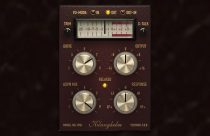
Includes a "tuning" control to affect the zoom ratio. A scope displays both the key signal and the output signal, so the use can see how the plug-in is operating, and help identify what controls need to be adjusted in order to track more accurately or produce the intended sound.A DC-offset switch corrects the input signal to improve tracking on rectified or offset signals.

Since the peaks/crests of the sine(ish) waves of the filtered key signal slow their rate of change at the point where they begin to change direction, crossing at this point instead of at the quick zero-crossing of the original waveform results in smoother transitions with less harmonics. The signal is then flipped in polarity when the peaks hit zero. Here, the key signal is DC-offset so that negative peaks sit at zero amplitude. A different version of a flipper circuit is used for this mode. Mode B is a more complex circuit, and a more accurate simulation of the original Boss OC-2 pedal. This abrupt change in direction causes additional harmonics, and results in a brassy tone (although can be filtered out). Mode A (old version) flips the polarity of the key signal directly at the positive zero-crossings. Polarity Multiplier has two modes: A and B.
#Octave vst full#
In phase-multiplier mode, the full dynamics of the key signal are retained.


Controls to all the typically fixed values for low-pass filters.It's unique from the Boss and other pedals, and other octaver plug-ins, in that it offers: It's based on the popular Boss OC-2 pedal, but with many more features and customizability far beyond what other octavers offer. OC-D2 is an octaver plug-in that generates a signal one and/or two octaves below the original.


 0 kommentar(er)
0 kommentar(er)
